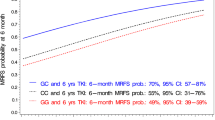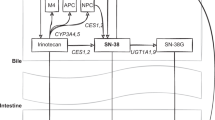Abstract
The aim of the study was to investigate any possible influence of polymorphisms of transmembrane transporters human organic cation transporter 1 (hOCT1), ABCB1, ABCG2 on imatinib pharmacokinetics in 33 men and 27 women (median age and range, 56 and 27–79 years, respectively) affected by chronic myeloid leukemia. A population pharmacokinetic analysis was performed to investigate imatinib disposition in every patient and the role of transporter polymorphisms. Results showed that the α1-acid glycoprotein and the c.480C>G genotype of hOCT1 had a significant effect on apparent drug clearance (CL/F) being responsible, respectively, for a 20% and 10% decrease in interindividual variability (IIV) of CL/F (from 50.1 up to 19.6%). Interestingly, 25 patients carrying at least one polymorphic c.480 G allele had a significant lower CL/F value with respect to the 35 c.480CC individuals (mean±s.d., 9.6±1.6 vs 12.1±2.3 l h−1, respectively; P<0.001). In conclusion, the hOCT1 c.480C>G SNP may significantly influence imatinib pharmacokinetics, supporting further analyses in larger groups of patients.
This is a preview of subscription content, access via your institution
Access options
Subscribe to this journal
Receive 6 print issues and online access
$259.00 per year
only $43.17 per issue
Buy this article
- Purchase on Springer Link
- Instant access to full article PDF
Prices may be subject to local taxes which are calculated during checkout




Similar content being viewed by others
References
Baccarani M, Castagnetti F, Gugliotta G, Palandri F, Soverini S, European Leukemia N . Response definitions and European leukemianet management recommendations. Best Pract Res Clin Haematol 2009; 22: 331–341.
Picard S, Titier K, Etienne G, Teilhet E, Ducint D, Bernard MA et al. Trough imatinib plasma levels are associated with both cytogenetic and molecular responses to standard-dose imatinib in chronic myeloid leukemia. Blood 2007; 109: 3496–3499.
Ishikawa Y, Kiyoi H, Watanabe K, Miyamura K, Nakano Y, Kitamura K et al. Trough plasma concentration of imatinib reflects BCR-ABL kinase inhibitory activity and clinical response in chronic-phase chronic myeloid leukemia: a report from the BINGO study. Cancer Sci 2010; 101: 2186–2192.
Takahashi N, Wakita H, Miura M, Scott SA, Nishii K, Masuko M et al. Correlation between imatinib pharmacokinetics and clinical response in Japanese patients with chronic-phase chronic myeloid leukemia. Clin Pharmacol Ther 2010; 88: 809–813.
Koren-Michowitz M, Volchek Y, Naparstek E, Gavish I, Levi I, Rowe JM et al. Imatinib plasma trough levels in chronic myeloid leukaemia: results of a multicentre study CSTI571AIL11TGLIVEC. Hematol Oncol 2012; 30: 200–205.
Faber E, Friedecky D, Micova K, Rozmanova S, Divoka M, Jarosova M et al. Imatinib trough plasma levels do not correlate with the response to therapy in patients with chronic myeloid leukemia in routine clinical setting. Ann Hematol 2012; 91: 923–929.
Maffioli M, Camos M, Gaya A, Hernandez-Boluda JC, Alvarez-Larran A, Domingo A et al. Correlation between genetic polymorphisms of the hOCT1 and MDR1 genes and the response to imatinib in patients newly diagnosed with chronic-phase chronic myeloid leukemia. Leuk Res 2011; 35: 1014–1019.
Seong SJ, Lim M, Sohn SK, Moon JH, Oh SJ, Kim BS et al. Influence of enzyme and transporter polymorphisms on trough imatinib concentration and clinical response in chronic myeloid leukemia patients. Ann Oncol 2013; 24: 756–760.
Thomas J, Wang L, Clark RE, Pirmohamed M . Active transport of imatinib into and out of cells: implications for drug resistance. Blood 2004; 104: 3739–3745.
Engler JR, Frede A, Saunders VA, Zannettino AC, Hughes TP, White DL . Chronic myeloid leukemia CD34+ cells have reduced uptake of imatinib due to low OCT-1 activity. Leukemia 2010; 24: 765–770.
Kim DH, Sriharsha L, Xu W, Kamel-Reid S, Liu X, Siminovitch K et al. Clinical relevance of a pharmacogenetic approach using multiple candidate genes to predict response and resistance to imatinib therapy in chronic myeloid leukemia. Clin Cancer Res 2009; 15: 4750–4758.
Angelini S, Soverini S, Ravegnini G, Barnett M, Turrini E, Thornquist M et al. Association between imatinib transporters and metabolizing enzymes genotype and response in newly diagnosed chronic myeloid leukemia patients receiving imatinib therapy. Haematologica 2013; 98: 193–200.
Giannoudis A, Wang L, Jorgensen AL, Xinarianos G, Davies A, Pushpakom S et al. The hOCT1 SNPs M420del and M408V alter imatinib uptake and M420del modifies clinical outcome in imatinib-treated chronic myeloid leukemia. Blood 2013; 121: 628–637.
Jonker JW, Wagenaar E, Mol CA, Buitelaar M, Koepsell H, Smit JW et al. Reduced hepatic uptake and intestinal excretion of organic cations in mice with a targeted disruption of the organic cation transporter 1 (Oct1 [Slc22a1]) gene. Mol Cell Biol 2001; 21: 5471–5477.
Jonker JW, Wagenaar E, Van Eijl S, Schinkel AH . Deficiency in the organic cation transporters 1 and 2 (Oct1/Oct2 [Slc22a1/Slc22a2]) in mice abolishes renal secretion of organic cations. Mol Cell Biol 2003; 23: 7902–7908.
Marin D, Bazeos A, Mahon FX, Eliasson L, Milojkovic D, Bua M et al. Adherence is the critical factor for achieving molecular responses in patients with chronic myeloid leukemia who achieve complete cytogenetic responses on imatinib. J Clin Oncol 2010; 28: 2381–2388.
Jabbour EJ, Kantarjian H, Eliasson L, Cornelison AM, Marin D . Patient adherence to tyrosine kinase inhibitor therapy in chronic myeloid leukemia. Am J Hematol 2012; 87: 687–691.
Beal SL . Commentary on significance levels for covariate effects in NONMEM. J Pharmacokinet Pharmacodyn 2002; 29: 403–410.
Jonsson EN, Karlsson MO . Xpose—an S-PLUS based population pharmacokinetic/pharmacodynamic model building aid for NONMEM. Comput Methods Programs Biomed 1999; 58: 51–64.
Lindbom L, Ribbing J, Jonsson EN . Perl-speaks-NONMEM (PsN)—a Perl module for NONMEM related programming. Comput Methods Programs Biomed 2004; 75: 85–94.
Bergstrand M, Hooker AC, Wallin JE, Karlsson MO . Prediction-corrected visual predictive checks for diagnosing nonlinear mixed-effects models. AAPS J 2011; 13: 143–151.
Savic RM, Karlsson MO . Importance of shrinkage in empirical bayes estimates for diagnostics: problems and solutions. AAPS J 2009; 11: 558–569.
Baccarani M, Dreyling M, Group EGW. Chronic myelogenous leukemia: ESMO clinical recommendations for diagnosis, treatment and follow-up. Ann Oncol 2009; 20 (Suppl 4): 105–107.
Common Terminology Criteria for Adverse Events (CTCAE), National Cancer Institute, NIH, Version 4.02 2009.
Excoffier L, Lischer HE . Arlequin suite ver 3.5: a new series of programs to perform population genetics analyses under Linux and Windows. Mol Ecol Resour 2010; 10: 564–567.
Buclin T, Widmer N, Biollaz J, Decosterd LA . Who is in charge of assessing therapeutic drug monitoring? The case of imatinib. Lancet Oncol 2011; 12: 9–11.
Petain A, Kattygnarath D, Azard J, Chatelut E, Delbaldo C, Geoerger B et al. Population pharmacokinetics and pharmacogenetics of imatinib in children and adults. Clin Cancer Res 2008; 14: 7102–7109.
Ciarimboli G, Struwe K, Arndt P, Gorboulev V, Koepsell H, Schlatter E et al. Regulation of the human organic cation transporter hOCT1. J Cell Physiol 2004; 201: 420–428.
Grundemann D, Gorboulev V, Gambaryan S, Veyhl M, Koepsell H . Drug excretion mediated by a new prototype of polyspecific transporter. Nature 1994; 372: 549–552.
Davies A, Jordanides NE, Giannoudis A, Lucas CM, Hatziieremia S, Harris RJ et al. Nilotinib concentration in cell lines and primary CD34(+) chronic myeloid leukemia cells is not mediated by active uptake or efflux by major drug transporters. Leukemia 2009; 23: 1999–2006.
Hegedus C, Ozvegy-Laczka C, Apati A, Magocsi M, Nemet K, Orfi L et al. Interaction of nilotinib, dasatinib and bosutinib with ABCB1 and ABCG2: implications for altered anti-cancer effects and pharmacological properties. Br J Pharmacol 2009; 158: 1153–1164.
Eechoute K, Fransson MN, Reyners AK, de Jong FA, Sparreboom A, van der Graaf WT et al. A long-term prospective population pharmacokinetic study on imatinib plasma concentrations in GIST patients. Clin Cancer Res 2012; 18: 5780–5787.
Acknowledgements
We thank Drs Francesco Ceccherini and Laura Galeotti, Phymtech, Pisa, for their critical review of the pharmacometric modelling adopted in the present study. Funds from the Regione Toscana to GC and the Ministry of Education, University and Research of Italy (MIUR, Grant number 2009TNXL9P) to SA are acknowledged. Furthermore, GB received a grant from Istituto Toscano Tumori.
Author information
Authors and Affiliations
Corresponding author
Ethics declarations
Competing interests
The authors declare no conflict of interest.
Rights and permissions
About this article
Cite this article
Di Paolo, A., Polillo, M., Capecchi, M. et al. The c.480C>G polymorphism of hOCT1 influences imatinib clearance in patients affected by chronic myeloid leukemia. Pharmacogenomics J 14, 328–335 (2014). https://doi.org/10.1038/tpj.2014.7
Received:
Revised:
Accepted:
Published:
Issue Date:
DOI: https://doi.org/10.1038/tpj.2014.7
Keywords
This article is cited by
-
Predictive performance of population pharmacokinetic models of imatinib in chronic myeloid leukemia patients
Cancer Chemotherapy and Pharmacology (2024)
-
Population pharmacokinetics and pharmacogenetics analyses of imatinib in Chinese patients with chronic myeloid leukemia in a real-world situation
Cancer Chemotherapy and Pharmacology (2023)
-
Role of ADME gene polymorphisms on imatinib disposition: results from a population pharmacokinetic study in chronic myeloid leukaemia
European Journal of Clinical Pharmacology (2022)
-
Imatinib-induced ophthalmological side-effects in GIST patients are associated with the variations of EGFR, SLC22A1, SLC22A5 and ABCB1
The Pharmacogenomics Journal (2018)
-
Association of the hOCT1/ABCB1 genotype with efficacy and tolerability of imatinib in patients affected by chronic myeloid leukemia
Cancer Chemotherapy and Pharmacology (2017)



